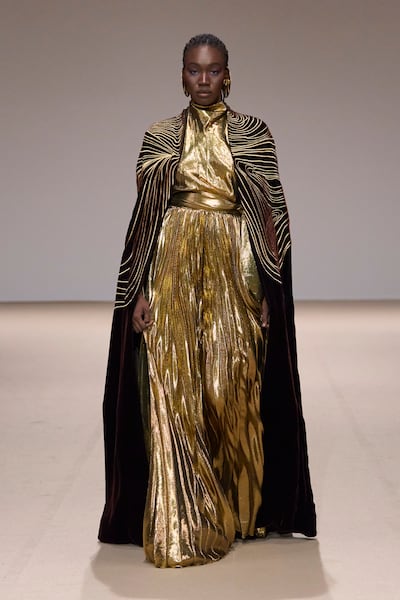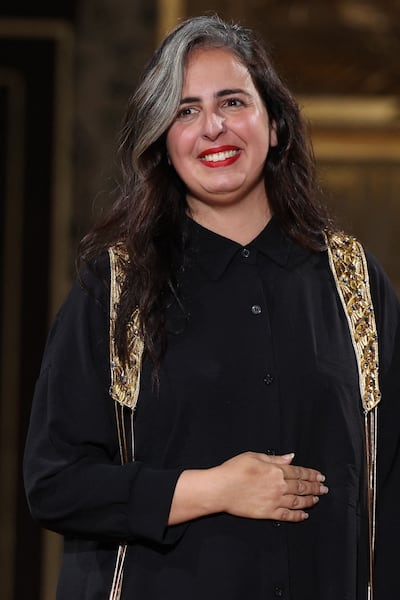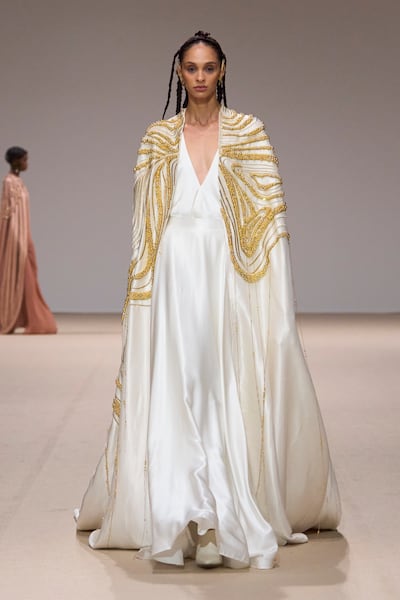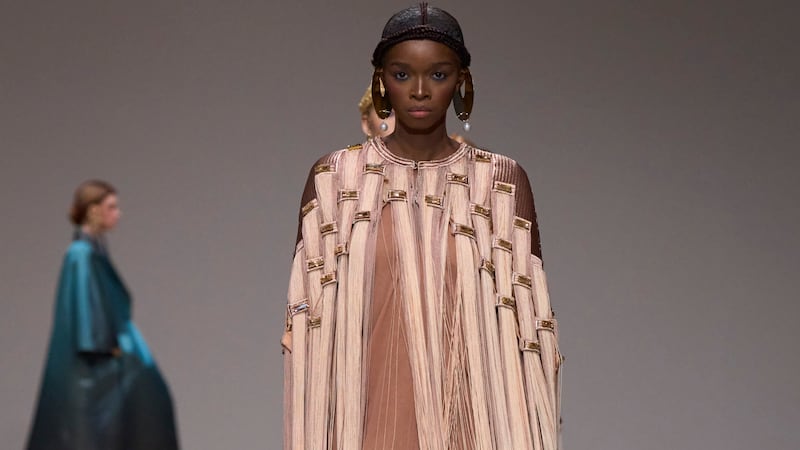Fresh off the back of her sensational haute couture show in Paris, Moroccan designer Sara Chraibi has arrived in the UAE with her eponymous label to showcase the same spring 2024 couture collection as part of Dubai Fashion Week.
“Maison Sara Chraibi is only haute couture at the moment,” the designer told The National, ahead of her debut last Monday. To enhance the collection, she even created additional looks for the occasion.
“For Dubai we added some extra drops, especially. We try to do something particular for Dubai.”
Given Chraibi is a member of the esteemed ranks of Parisian haute couture, bringing her collection to the UAE may seem a surprising move to some. It shouldn't, according to the designer, for whom the region holds great sway.
“You have the glamour of Paris, of course, but in Dubai there is something special. Ladies here are very beautiful, they wear these kind of dresses, and have special moments in their life where these kind of dresses are perfect for the occasion. Dubai is something special in the region.”

Knowing the exacting demands of clients in the region, Chraibi tasked her atelier with creating four additional looks, despite each demanding countless hours of work.
“It's worth it,” she said. “I want my clients to see the collection for real, that’s why I am here.”
The beauty of such high-level clothing, the designer explained, can only truly be appreciated up close.
“Haute couture is about feeling the material, the detail, the work, the hand beading, and sometimes is just about the construction of the dress. You have to see it very close.”
For Chraibi, creating such handmade masterpieces is the realisation of a childhood dream.
“I learnt sewing and embroidery from my mother when I was a child, and haute couture – and especially the Paris podium – was something I dreamt of since I was child.
“I studied architecture, but after that I started doing dresses for my friends, always looking to Paris. I did this beautiful collection that I was very proud of after Covid-19, and I thought at that time it was time to ask to be in the official haute couture calendar. I presented, and suddenly it worked.”
Admission to the tightly guarded ranks of haute couture is so notoriously difficult that most designers can only dream of it, yet Chraibi has managed it despite having no formal fashion training whatsoever.

“In fashion I am self-taught,” she says. “But I know how to do the work by hand. I know how to do embroidery. Plus I am an architect, so I know how to build patterns, and it's all about that – about building, about constructing the outfit.
“It's not just about a beautiful dress, I mean there are a lot of beautiful dresses, but for me what is important is to do something that is relevant, culturally relevant, that adds something, and that will give something special to the women who will wear it.
“I want to add something about the moment, about my country. I want to tell something about my roots, and I want to show it to the world.”
The key to using traditional handwork, she believes, is to not regard it as something fixed in time, but as an evolving medium that can meld towards new thinking and new ideals.
“If we keep the tradition as it was back in the time, it will not stay alive any more. To keep the savoir faire alive, we need to use it, to combine it, to redo, rethink, reconstruct it, and come up with something new.
“Obviously women are not in the 12th century any more, and we will not live in the past, so we have to make our thoughts contemporary. That doesn’t mean to do it without roots – roots are very important – but we also have to project it into the future.”
Such a determination to honour her past, yet to allow it to embrace the future has, she explains, been the force underpinning her work since the beginning.

“It's part of who I am. I cannot be somebody else, I don’t want to be that kind of designer to say I am not an Arab woman, I am not Muslim. No, I am Muslim, I am an Arab woman. I want to show something different, a different perspective and to show it to the world,” she says.
“Not to keep it as something local, but to show that to the world, with my own point of view. My point of view is North African, is Moroccan, is Muslim, and I am proud of that, because this is what makes my work unique.”
That's also one of the reasons she agreed to come to Dubai Fashion Week.
“I don’t want to be this kind of designer who always has to be seen through a western lens. We need to be proud of ourselves and to be proud of who we are. Yes, of course, I love showing in Paris, but my work is kind of a beautiful travel between East and West. I want to keep it consistent, to nourish it, nurture it, with oriental vibes and western vibes.”
Chraibi is the only woman from a handful of Arab designers who can call themselves haute couturiers. The list includes Elie Saab, Georges Hobeika, Zuhair Murad and, most recently, Saudi brand Ashi Studio.
“Bringing this feminine energy to haute couture, this feminine, Muslim, Arab energy is something very unique. It’s a new perspective,” she says.






